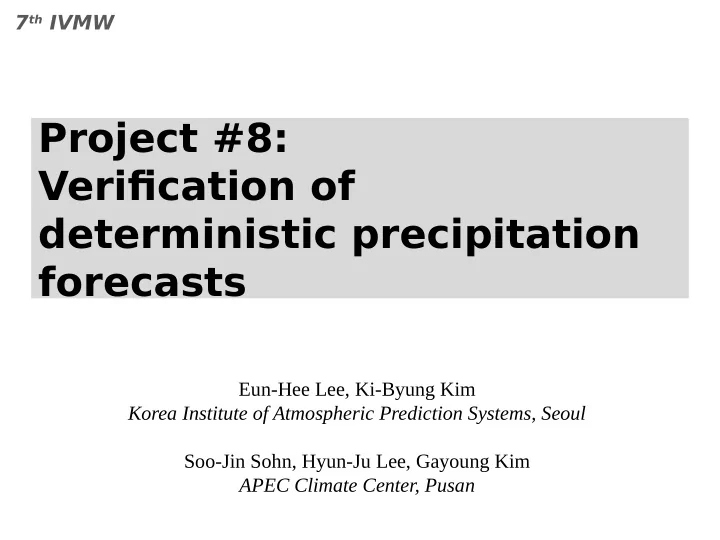

7 th IVMW Project #8: Verifjcation of deterministic precipitation forecasts Eun-Hee Lee, Ki-Byung Kim Korea Institute of Atmospheric Prediction Systems, Seoul Soo-Jin Sohn, Hyun-Ju Lee, Gayoung Kim APEC Climate Center, Pusan
Project #8 Verifjcatjon of deterministjc precipitatjon forecasts Daily precipitatjon 3 day predictjon data - By the KIAPS Integrated Model (KIM) : non-hydrostatjc global NWP model on the cubed sphere : Resolutjon ~25km [Location of observation stations] - JJA 2016, DJF 15/16 Observatjon - Rain gauge data from 617 statjons over Korean peninsula - Daily accumulated from hourly prcp. Verifjcatjon - Bilinear interpolatjon from model grid to obs. point - Verifjed using contjngency tables
JJA vs. DJF precipitation Daily precipitatjon (all statjon averages) [DJF 2015/16] [JJA 2016] JJA ~ rainy, prevailing persistent monsoonal rain period , followed by rainy days due to synoptic front, convective systems DJF ~ relatively dry season, local rainy events..
Data JJA16 +72 h prediction +24 h prediction +48 h prediction r=0.68 correlatjon, r=0.73 r=0.66 slope of regression a=0.49 a=0.52 a=0.62 Quite scatuered 70% of no-rain obs. Model Model under-predict (mm/day Model don’t capture ) extreme events OBS. (mm/day) For a longer lead tjme, Model tends to intensify rain DJF15/16 system for some events r=0.73 r=0.71 r=0.58 a=0.49 a=0.68 a=0.53
Data distribution & selected thresholds OBS [JJA 2016] MODEL OBS. Model Model OBS. observed rain only detectjon : >=0.1 mm (JJA16, fu +24h) [DJF 2015/16] Thresholds for contingency table verification Heavy rainfall warning by KMA: 110 mm/12hr Lowest 0.5 mm, highest 100 mm/day 0.5, 2, 5, 10, 20, 30, 50, 100 mm/day
Verification results (+48 h prediction) JJA Higher false alarm ratjo for smaller thresholds in JJA Higher hit rate for light rain for both JJA and DJF DJF Higher false alarm ratjo for heavier rain thresholds in DJF NO predic- tion
Verification results (+48 h prediction) JJA Over-predicted light rain & under-predicted heavier summer rain DJF Overall over-predictjon for all precipitatjon ranges Threshold = 50 mm/day 1-day lead OBS YES OBS NO Total 5 6 11 FCST YES 66 47462 47528 FCST NO 71 47468 47539 Total Threshold = 50 mm/day NO predic- tion 2-day lead OBS YES OBS NO Total 35 68 103 FCST YES 36 47400 47436 FCST NO Is this meaningful? 71 47468 47539 Total
Verification results (with lead times) Equitable Threat Score JJA DJF +24h prediction +48h +72h Betuer skill for higher thresholds in summer Betuer skill for lower thresholds in winter Predictjon skill is betuer for winter? Decrease of skill with forecast lead tjme shown in most thresholds range
Verification results (various scores) +24h prediction +48h +72h Result from JJA Various skill scores show difgerent characteristjcs with thresholds ETS, HSS increases with thresholds but not in EDI Small samples size afgects sharp decrease in certain skill score index like ETS, HSS
Summary Contjngency table method is applied to verify deterministjc precipitatjon fore- casts against rain-gauge observatjon over Korea. Thresholds are selected in consideratjon with data distributjon and extreme weather warning. Higher hit rate appears for light rain for both JJA and DJF. Higher false alarm ratjo for smaller thresholds in JJA afgects low skill score in summer, while higher false alarm ratjo for heavier rain thresholds in DJF. Decrease of skill with forecast lead tjmes is shown in most thresholds range. Small sample size afgects certain skill scores. Extreme events are diffjcult to measure with this contjngency table method. There are more issues about data quality control, grid-to-obs. interpolatjon, sample sizes, how to verify extreme events.
Verification results with lead times, DJF As forecast lead time is longer, POD decreasing False alarm increasing, BIAS increasing… Skills decreasing till sample number issues…
threshold = 100 mm/day OBS YES OBS NO Total FCST YES 11 13 24 FCST NO 366 49353 49719 Total 377 49366 49743 Threshold = 50 mm/day OBS YES OBS NO Total FCST YES 573 269 842 FCST NO 789 48112 48901 Total 1362 48381 49743 Threshold = 30 mm/day OBS YES OBS NO Total FCST YES 1295 447 1742 FCST NO 1209 46792 48001 Total 2504 47239 49743 JJA16
threshold = 100 mm/day OBS YES OBS NO Total FCST YES 0 0 0 FCST NO 9 47530 47539 Total 9 47530 47539 Threshold = 50 mm/day OBS YES OBS NO Total FCST YES 5 6 11 FCST NO 66 47462 47528 Total 71 47468 47539 Threshold = 30 mm/day OBS YES OBS NO Total FCST YES 93 31 124 FCST NO 229 47186 47415 Total 322 47217 47539 DJF15/16
Recommend
More recommend